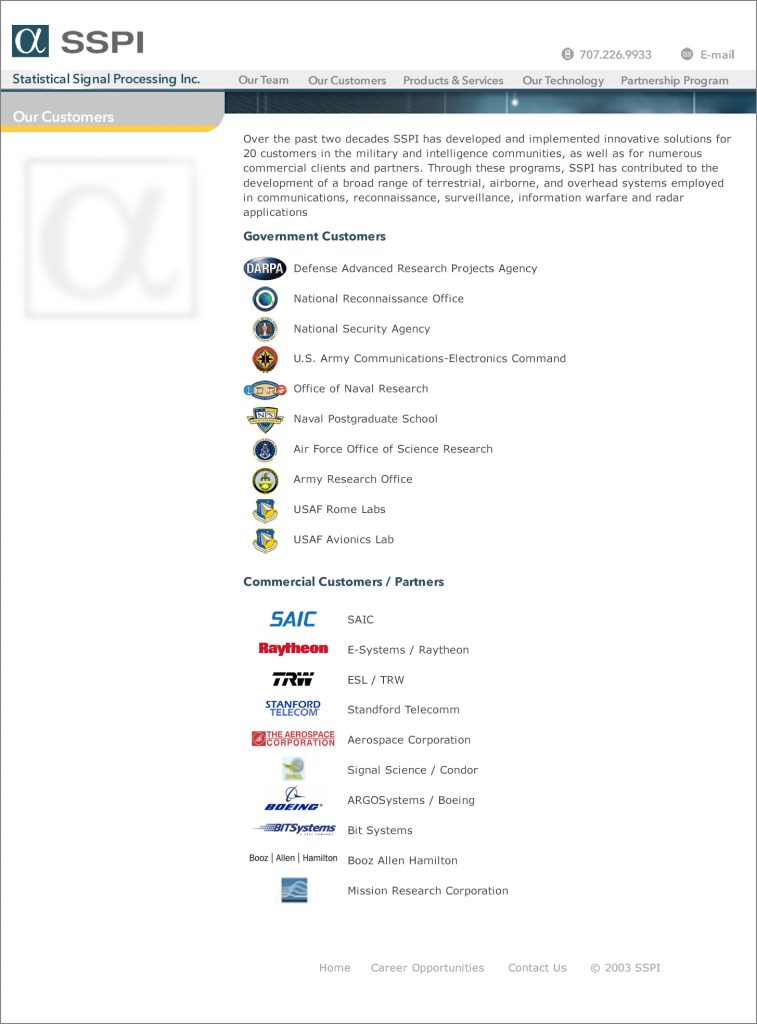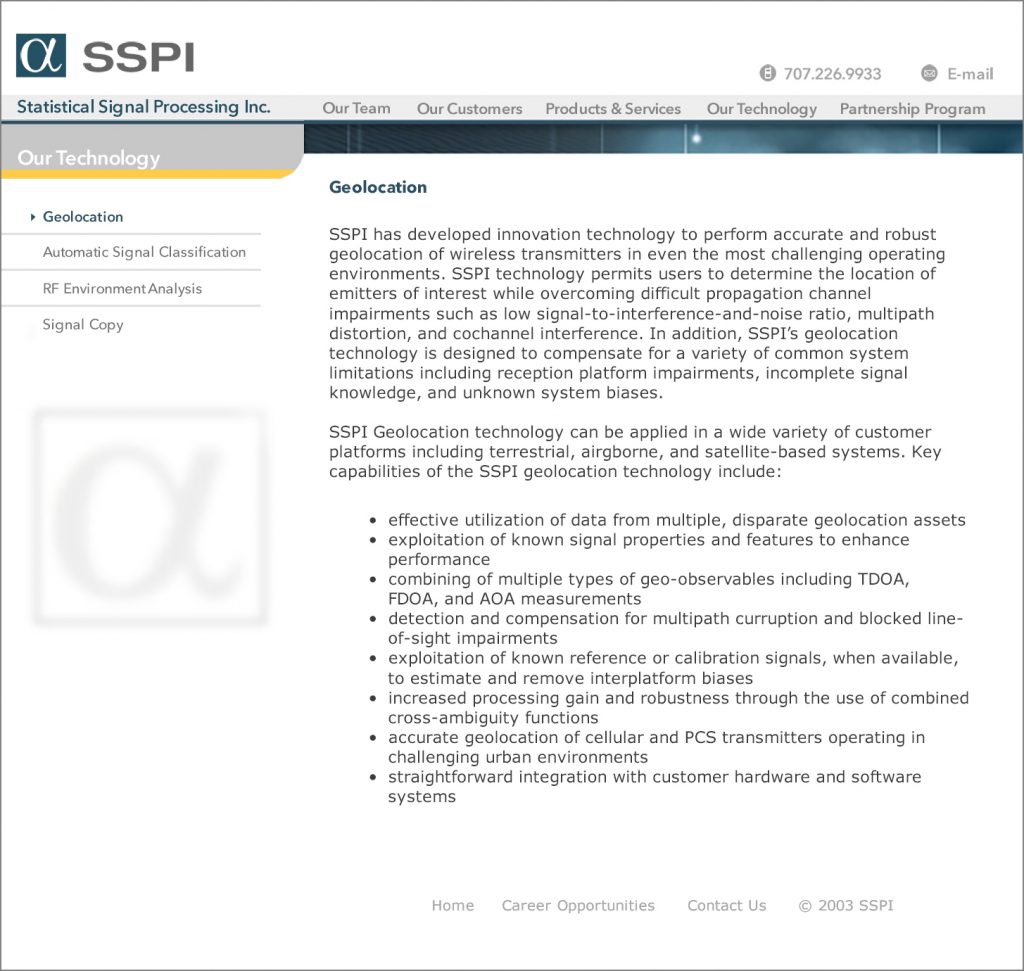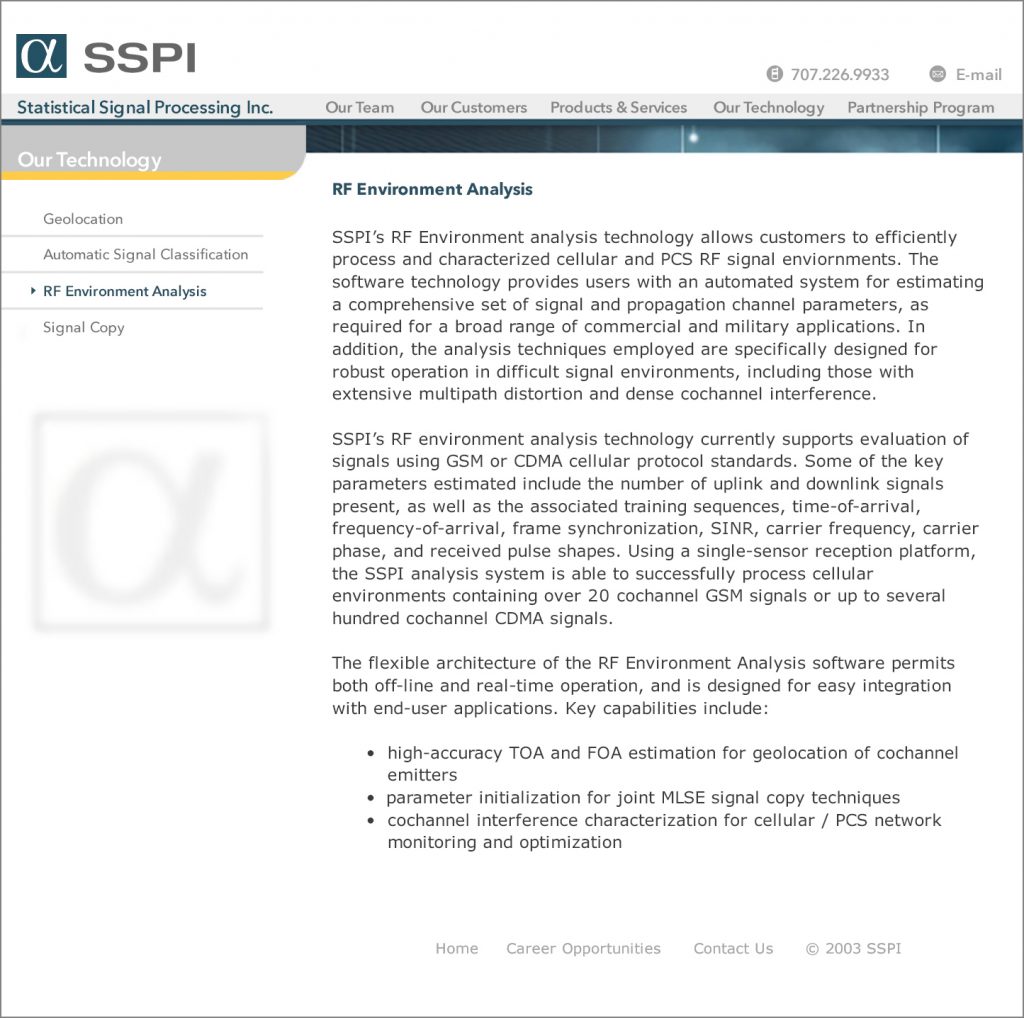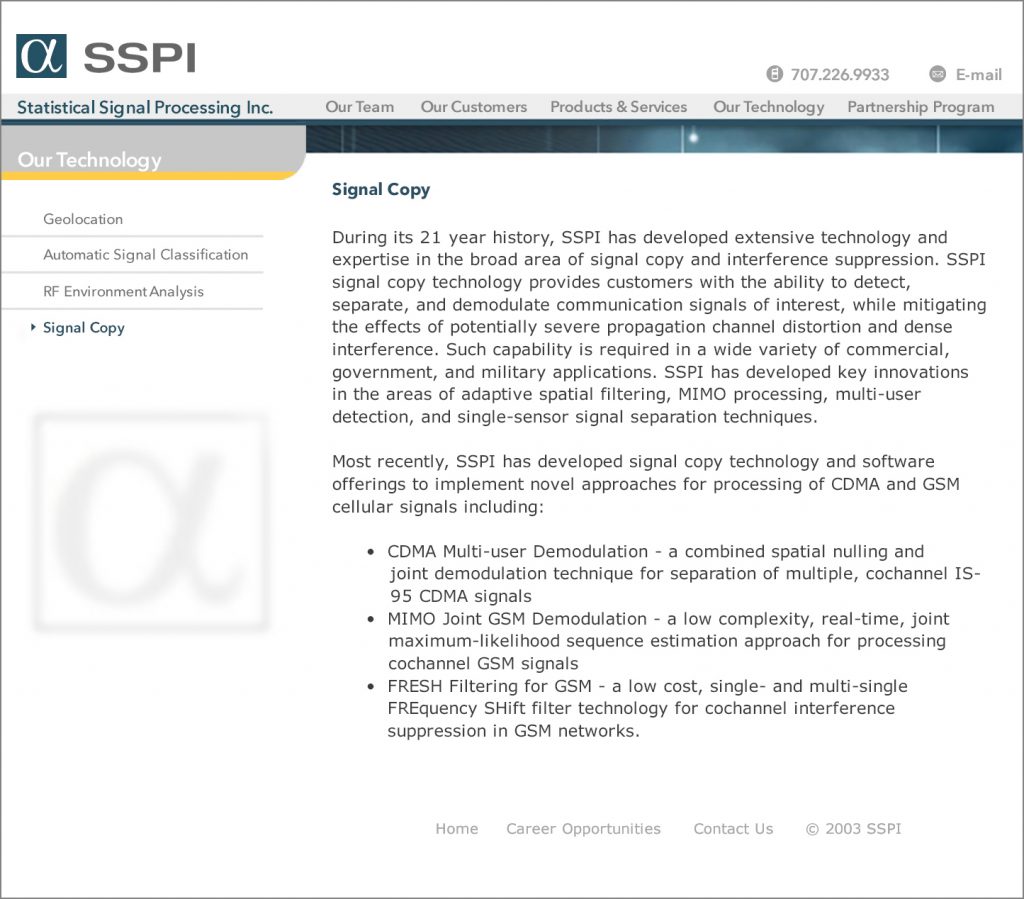Compared with the Nation’s largest defense contractors, the creativity and productivity in development of theory, method, algorithms, and software of the tiny R&D firm, SSPI (Statistical Signal Processing, Inc.), in the field of signals intelligence is nothing short of phenomenal. The SSPI team was comprised of fewer than ten employees, most of whom were trained by Professor Gardner, SSPI’s president and chief scientist, as PhD students and post-doctoral researchers at the University of California, Davis. The entire budget of SSPI over its 25-year lifetime was less than $25M. The company’s huge store of intellectual property was sold (in essence, gifted) in 2011 to Lockheed Martin Corporation at the time of Gardner’s retirement for a small fraction of this sum and an agreement for placement of SSPI’s senior engineers at the Lockheed Martin Advanced Technology Center in Palo Alto, California.
The following images were excerpted from a 2003 SSPI PowerPoint presentation. They provide a concise overview of some of the technology that was developed by SSPI during the first 15 years of its 25-year history from 1986 to 2011. Following this presentation is an in-depth summary of SSPI’s technology development during its final 10 years. Also available herein on Page 6 is an in-depth survey of SSPI’s early work on application of cyclostationarity theory and method to the specialized field of signal interception. This survey was written 5 years after the 1987 publication of the enabling book [Bk2].






Following is an outline of SSPI’s developed technology in the area of communications signal processing specifically for unintended receivers, as of the end of 2010. The great majority of SSPI’s technology is in the form of technical documents and software (scientific/engineering documentation of innovative theory, methodology, algorithms, software implementations of individual signal processing algorithms and data processing systems of such algorithms, and performance-evaluation data and analysis). These theoretical and methodological results were developed without outside funding. The sources of funding include investments-in-kind of the Owner’s labor, SSPI IRAD funding not billed to any clients as an overhead expense, and some (Items 1e, 2c, and 3c) SSPI IRAD funding billed as an overhead expense to contracting customers.
Researchers seeking insight into theory and method for the following topics, as reflected in the topics outlined on this page 12.1, should benefit from the sources cited on pages 2.5 and 6: adaptive filtering algorithms, adaptive equalization algorithms, adaptive noise reduction algorithms, least mean square (LMS), recursive least squares (RLS), normalized least mean squares (NLMS), stochastic gradient descent (SGD), channel identification, channel equalization, blind equalization, blind channel equalization, weak signals, weak signal detection, weak communications signals, detection of weak communications signals, adaptive spatial filtering algorithms, emitter location, RF geolocation, radio source location, radio direction finding, triangulation, time difference of arrival estimation, frequency difference of arrival, communications signal classification and modulation classification, time series prediction and forecasting.
Reaching back farther into the early 1980s, in connection with my work on exploiting cyclostationarity to despread a Direct-Sequence Spread Spectrum signal without using the spreading code (eventually published in the paper [JP14]), Professor Herschel H. Loomis of the Naval Postgraduate School (NPS) in Monterey, California, brought to my attention a class of signal processing problems needing solutions which he suggested may be amenable to techniques based on exploitation of cyclostationarity. This class of problems, referred to as Signal Interception, belongs to the broader field of what is called Signals Intelligence. The focus of applications of my work on cyclostationarity was originally commercial communications systems, a natural outgrowth of my pre-doctoral work at Bell Telephone Laboratories. The signals intelligence problems that SSPI addressed involved primarily radio frequency wireless communications systems, both commercial and military, but was distinct from my earlier work in that the problems addressed arose from the perspective of unintended receivers wanting to extract information from received signals that would be of value for gathering intelligence for the purpose of national defense.
This gave rise to a collaboration that led to the expansion of my modest consulting services to commercial industry into an incorporated research and development firm, SSPI (Statistical Signal Processing Inc.), consisting initially of a group of M.S. and Ph.D. students working on thesis projects at the University of California, Davis, and later expanding to include post-doctoral employees from UCD and elsewhere. In parallel with this development, there was the development of an academic group at NPS, under the direction of Professor Loomis. Whereas SSPI focused on the development of theory and method for tackling signals intelligence challenges, the NPS group focused more on evaluating specific techniques suggested by the theory and associated methodology. This synergistic relationship continued into the early 1990s. Following the first workshop on cyclostationarity in 1992, held in SSPI’s hometown of Yountville, California, and co-sponsored by four independent funding agencies, the National Science Foundation and the Offices of Research of the Army, Navy, and Air Force, SSPI’s customer base grew substantially. Although this detracted from the extent of collaboration between SSPI and NPS, the NPS effort on evaluating cyclostationarity-exploiting techniques also continued to grow, as illustrated in the chronological list of NPS thesis projects included below, which covers the 26-year period from 1983 to 2009.
In addition to UCD and NPS, a key role in applications to signals intelligence was also played by the AFIT (US Air Force Institute of Technology), and other institutions as briefly discussed on Page 6.
UCD Thesis Projects
NPS Thesis Projects